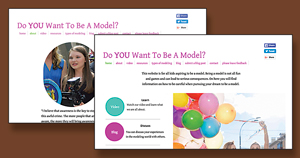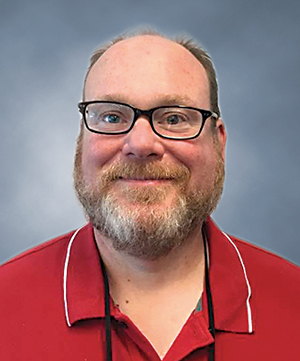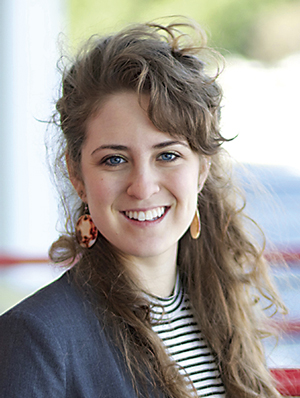Lily Goodman of Richmond is the poster child, literally, for human trafficking, though she isn’t herself a victim.
A successful child model for more than a decade, at age twelve she was chosen to portray a victim for an ad campaign by the U.S. Department of Homeland Security, designed to draw awareness to what is often a hidden crime.
The job opened her eyes to a scary and dangerous world – and one the young teen never realized was so prevalent.

Now sixteen and a student at St. Catherine’s School, Lily Goodman works for a legitimate modeling agency and has always had a parent or chaperone watching out for her at every job. But she’s aware that other girls may not be so lucky. She’s seen the “models wanted” ads, and knows that many girls who respond will end up in seedy motels instead of fashion magazines. Those ads often are part of a dark world that preys on youth with promises of money, love, and fame, and then exploits them, often right under our noses.
Human trafficking is big business – across the world and in Central Virginia. According to the federal Department of Health and Human Services, it’s also the fastest growing crime in America and third most profitable (behind weapons and drugs). Three out of four cases involve U.S. citizens. According to the National Coalition Against Domestic Violence, 50 percent of trafficked victims are under eighteen, and in the United States, 300,000 children are at risk of becoming victims of trafficking and sexual exploitation.

The Polaris Project, an organization that works to end trafficking and aid its victims, notes, “Although slavery is commonly thought to be a thing of the past, human traffickers generate hundreds of billions of dollars in profits by trapping millions of people in horrific situations around the world, including here in the U.S. Traffickers use violence, threats, deception, debt bondage, and other manipulative tactics to force people to engage in commercial sex or to provide labor or services against their will.”
Goodman was stunned when she learned that. “It was shocking to think that there are more people being exploited in slavery today than before the Civil War.”
Just as it’s important to understand that slavery isn’t a thing of the past, it is also necessary to recognize that trafficking isn’t solely occurring in nations half-a-world away. It happens in every city, even in the best neighborhoods. Predators find children on the streets, on social media, and even through their friends. Once a young person is caught in a web of deception and intimidation, situations can seem hopeless. Predators give them what they need or come to need: the appearance of caring or love, shelter, food, alcohol, and drugs.

According to the National Human Trafficking Resource Center, Virginia consistently has the fifth highest number of human trafficking cases referenced on its national hotline. Experts cite our location on the East Coast, international air and sea ports, and large number of major interstates. Furthermore, while trafficking drugs or weapons requires a constant supply of new product and carries a risk of high penalties, human traffickers can resell a single victim over and over again with little risk.
While sex trafficking may be the most notorious type of trafficking, be aware that labor trafficking also is a reality in Central Virginia, says Robert Franklin, sexual and domestic violence community outreach coordinator at the Virginia Department of Health. It can be difficult to identify and to remediate. “If you were being prostituted, I can separate you from your handlers. I can get you away and into services. But it’s not against the law to be a dishwasher, for example. You could be working eighteen hours a day for fifty cents an hour, but it’s harder to see, and it’s harder to pull you
away from that.”
A network of professionals – from the fields of criminal justice, social work, education, and more – and committed volunteers from all over Richmond are determined to fight human trafficking. To do that effectively, they need to define it, and shatter some stereotypes.
First of all, says Fay Chelmow, minors do not choose to be prostitutes. “They are prostituted people. There is a movement away from describing sex trafficking as prostitution. They are victims. That’s the law.”
Chelmow is founder and president of imPACT, a local nonprofit that addresses the issue of human trafficking, with a particular emphasis on keeping it out of schools.
Chelmow, a registered nurse turned activist, admits she was someone who used to write a check and feel like she did her part. But as she volunteered at a safe house for victims, she knew she had found her calling. She likens it to experiences she had as a hospice nurse caring for dying patients“But these people are not dying. They are young and healthy, and have full lives ahead of them. I knew I had to act.”

Secondly, human trafficking isn’t necessarily a matter of the victim being abducted and held against his or her will. Joell Maisano, prevention project manager at the Richmond Justice Initiative, explained, “There’s a myth that trafficking has to involve smuggling, be synonymous with kidnapping, or involve physical restraint. That isn’t always true. Lots of people are fooled into thinking that if they’re not being grabbed away from homes, they’re not trafficked.” Many victims are brainwashed to believe they are in a loving relationship so they protect their trafficker.
A more vile part of trafficking – and the part many people don’t want to fathom – is that some children are sold by their parents or trusted family friends.
That’s what happened to Elisabeth Corey, who grew up in Stafford County. She says people don’t typically think of her as a victim or a survivor because she doesn’t fit the stereotype. “I grew up in a white, middle-class neighborhood, with a mother and father in our home. And I was trafficked by my father. He sold me to his friends.
“It’s important for parents to hear that we need to break the stereotype of trafficking. The media focuses on the aspects of trafficking that are internationally based, so movies like Taken [which focuses on international smuggling and exploitation] almost do a disservice by promoting the stereotypes. That’s the white van pulling up and stealing your kid. So what happens is, we won’t let our kids walk ten feet down the street because of stranger danger, but we’re oblivious to the fact that there might be some friend of the family [who is a potential threat to a child’s safety].”
While her home life was chaotic, Corey found that school was a place where she could understand the rules. “School was my safe place,” she said.
But unfortunately, school isn’t always a safe place. Eve Birge, an education program specialist at the U.S. Department of Education, noted at a summit earlier this summer, “Children in every school are vulnerable. Increasingly, schools are targets for recruiters.”
That fact keeps Chelmow awake at night. “Schools are being used by traffickers as venues to scout for and lure vulnerable youth into commercial exploitation.”
And what’s really shocking, she says, is that many predators now recruit students to recruit their classmates to work as prostitutes. Chelmow believes that many of these young middlemen don’t fully understand what is happening to their peers.
Chelmow and others applaud Virginia Legislators for passing Senate Bill 259 in 2012, requiring the Virginia State Board of Education to provide awareness and training materials on human trafficking of youth to local school divisions. Schools are now mandated to provide education to their staff on human trafficking, including strategies for the prevention of trafficking of youth. The Virginia PTA, in its 2012 Resolution on Child Trafficking, is “encouraging its constituent organizations to support their public schools and communities in providing awareness training and advocate for prevention strategies.” Those strategies involve identifying students who may be at risk or may already be victims, and offering them appropriate resources and follow-up care.

Virginia was the last state in the U.S. to adopt such legislation. And in reality, public school systems are already stretched thin, and don’t always have time to train teachers or offer the curriculum. It’s easy to turn a blind eye to the issue or attempt to avoid involvement. For example, earlier this summer in Chesterfield, a man was sentenced to twenty years in prison for enticement of a minor and sex trafficking of children. Posing as a 15-year-old girl, he used the Kik Messenger app to meet a local high school student, eventually convincing her to have sex with older men for money. Prosecutors said he knew the juvenile was a minor, and brazenly picked her up from school several times in front of others.
Predators like this have honed their abilities to spot potential victims, which is why communities need to be alert. The Department of Homeland Security notes that traffickers prey on victims with little or no social safety nets. They’re looking for vulnerabilities: students with disabilities; those from broken or poverty-stricken homes; young people with poor self-esteem; or those who are at odds with their parents or caregivers. Many are runaways or homeless, and many more have already been abused as children. LGBT youth are especially at risk.
“Traffickers can spot these kids from a mile away,” said Chelmow. And then they tell them what they have been longing to hear.
“The traffickers’ promises of love, family, and belonging are huge,” said Kristina Vadas, sexual assault response coordinator at the Virginia Department of Criminal Justice. Perhaps there are assurances of meeting celebrities, wealth and fame, or romance.

As a high school student, Tanya Street was lured into a life of prostitution by an older man she believed was her boyfriend. She now works to educate others to prevent such abuse. It’s important to start talking to children early about their bodies and boundaries, says Street.
“This really can empower the kids,” she says. “The parent is saying, ‘I’m not going to be in school with you, and you may see bad things happen.’ Make sure kids know you’ll listen and you’ll do something. You’re building a partnership, a sense of trust.”
That partnership between parent and child can strengthen initiatives between schools and other entities charged with protecting young people. Virginia, though slow to adopt anti-trafficking legislation and curricula, counts some successes where it has been implemented.
Prince William County Public Schools were the first in the nation to provide a comprehensive school-based program, which brought to light several cases of human trafficking.
The Richmond Justice Initiative created its Prevention Project curriculum that’s been adopted by Henrico County Public Schools and some youth groups and afterschool programs. “We train teachers to teach it because we believe teachers are best-equipped to know the location, and the students, and what they need. We make sure schools are equipped and prepared to deal with a human trafficking situation before they teach it [the curriculum] and someone comes forward,” said Maisano.
While these programs are yielding results, education alone is not enough to prevent trafficking. Ultimately, it’s up to parents to empower children to recognize threats and avoid danger.

Corey, who has a master’s degree in social work and works with other trafficking survivors, says, “The most important thing we can do as parents is teach our children to respond to strangers with confidence and strong boundaries.”
“It can be difficult because most kids are raised to be courteous,” notes Maisano. “But tell them that they don’t owe anybody anything, and that they have Mom or Dad’s permission to say no.”
Lily Goodman can relate to kids’ desire for privacy and autonomy, but her experience and research has led her to believe that it’s essential for parents and caregivers to monitor their children on social media. Her Girl Scout Gold Award project is a website aimed towards 8- to 12-year-olds who want to model, and includes information on staying safe in the modeling industry. The website will be optimized so that search engines will display the entry near the top of the page results when users are looking for information on modeling.
What to Look For, How to Help
In addition to educating your own children, experts encourage parents to keep an eye on others who may be powerless to say anything. It’s a hard call to make, but sometimes you have to trust your gut and get involved. “It’s better to be on the side of ‘at least I did my part’ instead of ‘I wish I did,’” says survivor and youth advocate Tanya Street, who now lives in Hampton Roads.
The U.S. State Department lists some red flags that could indicate trafficking:
• Living with employer
• Poor living conditions
• Multiple people in cramped space
• Inability to speak to the individual alone
• Answers appear to be scripted or rehearsed
• Signs of physical abuse
• Submissive or fearful
• Unpaid or paid very little
The State Department says these sample questions may shed some light on the situation, but only if one can speak privately to a suspected victim:
• Can you come and go as you please?
• Have you been hurt or threatened if you tried to leave?
• Has your family been threatened?
• Do you live with your employer?
• Where do you sleep and eat?
• Are you in debt to someone?
• Do you have your identification?
What if a victim comes forward? First and foremost, says Kristina Vadas with the Department of Criminal Justice, is to believe the person who says he or she is being trafficked – and don’t assign any blame. It’s essential to maintain privacy, confidentiality, and dignity as you ask questions and pay close attention.
There are many organizations that address the issue and provide resources, including:
• National Human Trafficking Resource Center, 1-888-373-7888
• Department of Homeland Security, 1-866-347-2423, or submit a tip online at www.ice.gov/tips
• U.S. Department of Justice, 1-888-428-7581 (all victims, including undocumented individuals, are eligible for services and immigration assistance)





